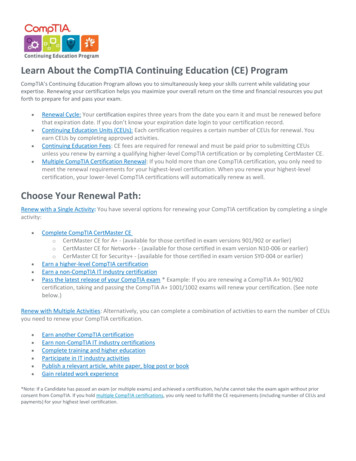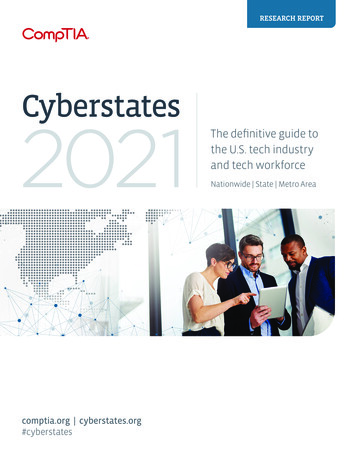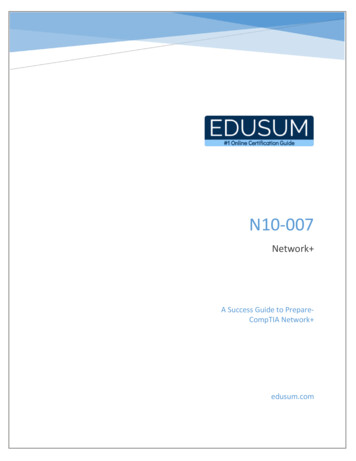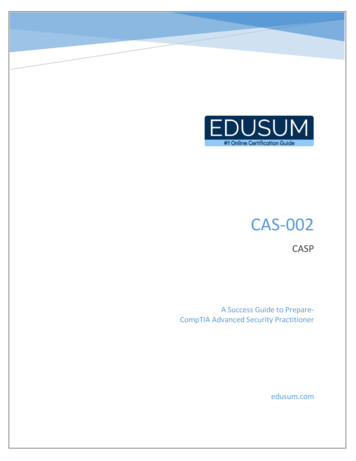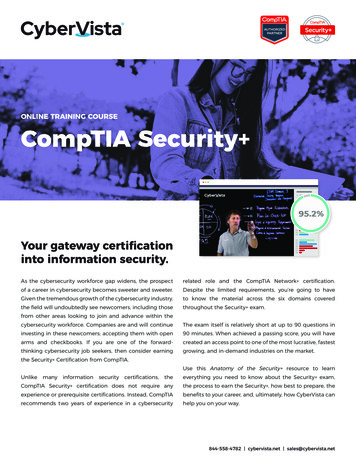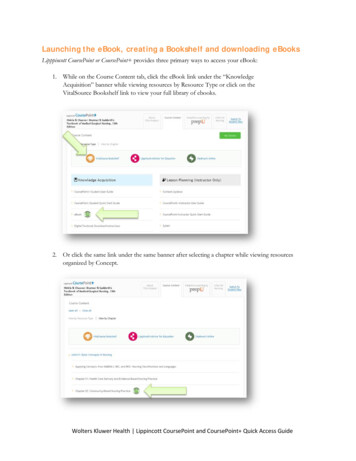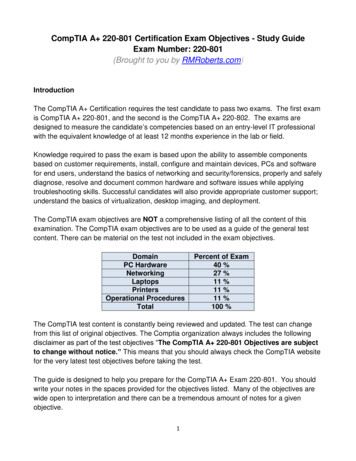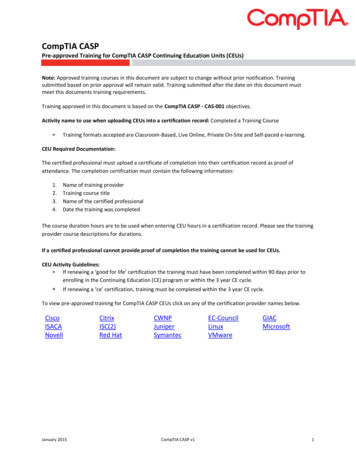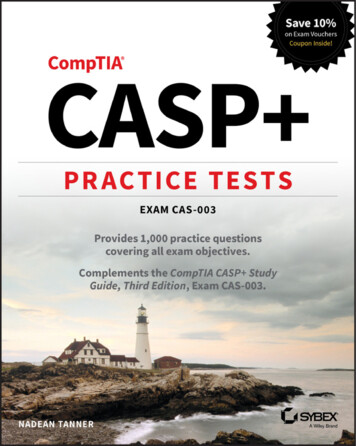
Transcription
CompTIA CASP Practice TestsEXAM CAS-003
CompTIA CASP Practice TestsEXAM CAS-003Nadean H. Tanner
Copyright 2020 by John Wiley & Sons, Inc., Indianapolis, IndianaPublished simultaneously in CanadaISBN: 978-1-119-68372-8ISBN: 978-1-119-68374-2 (ebk.)ISBN: 978-1-119-68373-5 (ebk.)No part of this publication may be reproduced, stored in a retrieval system or transmitted in any form or by anymeans, electronic, mechanical, photocopying, recording, scanning or otherwise, except as permitted under Sections107 or 108 of the 1976 United States Copyright Act, without either the prior written permission of the Publisher, orauthorization through payment of the appropriate per-copy fee to the Copyright Clearance Center, 222 RosewoodDrive, Danvers, MA 01923, (978) 750-8400, fax (978) 646-8600. Requests to the Publisher for permission shouldbe addressed to the Permissions Department, John Wiley & Sons, Inc., 111 River Street, Hoboken, NJ 07030, (201)748-6011, fax (201) 748-6008, or online at www.wiley.com/go/permissions.Limit of Liability/Disclaimer of Warranty: The publisher and the author make no representations or warrantieswith respect to the accuracy or completeness of the contents of this work and specifically disclaim all warranties,including without limitation warranties of fitness for a particular purpose. No warranty may be created or extendedby sales or promotional materials. The advice and strategies contained herein may not be suitable for every situation.This work is sold with the understanding that the publisher is not engaged in rendering legal, accounting, or otherprofessional services. If professional assistance is required, the services of a competent professional person shouldbe sought. Neither the publisher nor the author shall be liable for damages arising herefrom. The fact that anorganization or Web site is referred to in this work as a citation and/or a potential source of further informationdoes not mean that the author or the publisher endorses the information the organization or Web site may provideor recommendations it may make. Further, readers should be aware that Internet Web sites listed in this work mayhave changed or disappeared between when this work was written and when it is read.For general information on our other products and services or to obtain technical support, please contact ourCustomer Care Department within the U.S. at (877) 762-2974, outside the U.S. at (317) 572-3993 or fax (317) 5724002.Wiley publishes in a variety of print and electronic formats and by print-on-demand. Some material included withstandard print versions of this book may not be included in e-books or in print-on-demand. If this book refers tomedia such as a CD or DVD that is not included in the version you purchased, you may download this material athttp://booksupport.wiley.com. For more information about Wiley products, visit www.wiley.com.Library of Congress Control Number: 2020938995TRADEMARKS: Wiley, the Wiley logo, and the Sybex logo are trademarks or registered trademarks of John Wiley& Sons, Inc. and/or its affiliates, in the United States and other countries, and may not be used without writtenpermission. All other trademarks are the property of their respective owners. John Wiley & Sons, Inc. is notassociated with any product or vendor mentioned in this book.
6b 65 6e 6e 65 74 68 2c 20 69 20 6c 6f 76 65 20 79 6f 75 21
AcknowledgmentsTo Kenneth, thank you for all the love and question suggestions and for cooking dinnerwhen I had a deadline.To Shelby and Gavin, thank you for your patience and encouragement and for eating thedinners Daddy cooked.To Kenyon Brown for making the ask, to Jan Lynn for keeping me on task, and to mydearest friend, Ryan Hendricks, for making sure I was right. I couldn’t have done thiswithout such talent and dedication.And, to those of you taking the CASP exam, whether you volunteered or were voluntold—this book is for you. Best of luck, you got this!
About the AuthorNadean Hutto Tanner is the senior manager of Technical Education Strategy for Puppet software. Prior to Puppet, she was thelead instructor at Rapid7 teaching Nexpose, incident detection andresponse, and Metasploit. For more than 20 years, she has workedin academia as the IT director at a private school and a technologyinstructor at the university level. Tanner holds many industry certifications including the following:ISC2: CISSP CompTIA: A , Network , Security , Server , CTT , CIOS, CNIP, CSIS, CASP ITIL: ITILv3Microsoft: MCTS, MCITP, MCSA, MCT, MCP, MOSRapid7: IICS, IVMCA, MPCS, NACA, NCPTanner has trained and consulted for Fortune 50 companies in cybersecurity and security awareness, and has received hands-on experience working for the Department ofDefense.She is the author of the Cybersecurity Blue Team Toolkit, published by Wiley in 2019.
About the Technical EditorRyan Hendricks (CISSP, CEH, CASP , Security ) has more than 15 years of cybersecurityand intelligence experience. His first venture was working on intelligence operations forthe U.S. Navy; he continued in the government and private sectors as an educator, facilitator, consultant, and advisor for a multitude of information technology and cybersecurity principals.Hendricks holds many certifications covering hardware, networking, operating systems,and cybersecurity. He worked as a trainer for the U.S. Department of Defense, educatinghundreds of students on everything from military communication systems to the CompTIACASP and (ISC)2 CISSP certifications.Hendricks currently supports all technical product training operations at VMwareCarbon Black, including creating content, developing labs, updating materials, piloting andexpanding the certification programs, mentoring and managing the training team, and educating anyone who is willing to learn. When not working, he tries to balance spending histime learning new security tools and attack techniques to feed his need for knowledge andplaying video games with his kids.
Contents at a GlanceIntroductionxviiChapter1Risk ManagementChapter2Enterprise Security Architecture37Chapter3Enterprise Security Operations89Chapter4Technical Integration of Enterprise Security127Chapter5Research, Development, and Collaboration173Chapter6Practice Test 1199Chapter7Practice Test 2217Answers to Review Questions235AppendixIndex1353
ContentsIntroductionxviiChapter1Risk ManagementChapter2Enterprise Security Architecture37Chapter3Enterprise Security Operations89Chapter4Technical Integration of Enterprise Security127Chapter5Research, Development, and Collaboration173Chapter6Practice Test 1199Chapter7Practice Test 2217Answers to Review Questions235AppendixChapter 1: Risk ManagementChapter 2: Enterprise Security ArchitectureChapter 3: Enterprise Security OperationsChapter 4: Technical Integration of Enterprise SecurityChapter 5: Research, Development, and CollaborationChapter 6: Practice Test 1Chapter 7: Practice Test 2Index1236255278298320333342353
IntroductionCompTIA CASP (CompTIA Advanced Security Practitioner) Practice Tests is acompanion volume to CompTIA CASP (CompTIA Advanced Security Practitioner) StudyGuide (Wiley, 2019, Parker/Gregg). If you’re looking to test your knowledge before youtake the CASP exam, this book will help you by providing a combination of 1,000 questions that cover the five CASP domains and by including easy-to-understand explanationsof both right and wrong answers.If you’re just starting to prepare for the CASP exam, we highly recommend that youuse CompTIA Advanced Security Practitioner (CASP ) Study Guide to help you learnabout each of the domains covered by the CASP exam. Once you’re ready to test yourknowledge, use this book to help find places where you might need to study more or topractice for the exam itself.Because this is a companion to CASP Study Guide, this book is designed to besimilar to taking the CASP exam. It contains multi-part scenarios as well as standardmultiple-choice questions similar to those you may encounter on the certification exam.CompTIACompTIA is a nonprofit trade organization that offers certification in a variety of IT areas,ranging from the skills that a PC support technician needs, which are covered on theA exam, to advanced skills like the CompTIA Advanced Security Practitioner (CASP )certification. CompTIA divides its exams into four categories based on the skill levelrequired for the exam and the topics it covers, as shown essionalCloud ITF CySA CTT Linux A PenTest Cloud Essentials Server Network CASP Project Security As you can see, the CompTIA Advanced Security Practitioner certification fits intothe Cybersecurity category, which is the same place you’ll find the popular A , Network ,and Security credentials. The CompTIA Advanced Security Practitioner exam is a moreadvanced exam, intended for professionals with 10 years of hands-on experience who possess the knowledge covered by all of the prior exams.CompTIA certifications are ISO and ANSI accredited, and they are used throughoutmultiple industries as a measure of technical skill and knowledge. In addition, CompTIA
xviiiIntroductioncertifications, including the Security and the CASP , have been approved by the U.S.government as information assurance baseline certifications and are included in the StateDepartment’s Skills Incentive Program.The CompTIA Advanced SecurityPractitioner ExamThe CompTIA Advanced Security Practitioner exam, which CompTIA refers to as theCASP , is designed to be a vendor-neutral certification for cybersecurity, threat, and vulnerability analysts. The CASP certification is designed for security analysts and engineers as well as security operations center (SOC) staff, vulnerability analysts, and threatintelligence analysts. It focuses on security analytics and practical use of security tools inreal-world scenarios.The CASP exam is conducted in a format that CompTIA calls performance-basedassessment. This means the exam uses hands-on simulations using actual security tools andscenarios to perform tasks that match those found in the daily work of a security practitioner. Exam questions may include many types of questions such as multiple-choice, fill-inthe-blank, multiple-response, drag-and-drop, and image-based problems.CompTIA recommends that test takers have 10 years of information security–relatedexperience before taking this exam. The exam costs 439 in the United States, with roughlyequivalent prices in other locations around the globe. You can find more details about theCASP exam and how to take it at dvanced-security-practitioner.Study and Exam Preparation TipsWe recommend you use this book in conjunction with CompTIA Advanced Security Practitioner (CASP ) Study Guide. Read through chapters in the study guide and then tryyour hand at the practice questions associated with each domain in this book.You should also keep in mind that the CASP certification is designed to test practicalexperience, so you should also make sure you get some hands-on time with the securitytools covered on the exam. CompTIA recommends the use of NetWars-style simulations,penetration testing and defensive cybersecurity simulations, and incident response trainingto prepare for the CASP .Additional resources for hands-on exercises include the following: Exploit-Exercises.com provides virtual machines, documentation, and challenges covering a wide range of security issues at exploit-exercises.com /.
Introduction xixHacking-Lab provides capture-the-flag (CTF) exercises in a variety of fields at www.hacking-lab.com/index.html.The OWASP Hacking Lab provides excellent web application–focused exercises atwww.owasp.org/index.php/OWASP Hacking Lab.PentesterLab provides subscription-based access to penetration testing exercises atwww.pentesterlab.com/exercises/.Because the exam uses scenario-based learning, expect the questions to involve analysisand thought, rather than relying on simple memorization. The questions in this book areintended to help you be confident that you know the topic well enough to think throughhands-on exercises.Taking the ExamOnce you are fully prepared to take the exam, you can visit the CompTIA website to purchase your exam voucher.www.comptiastore.com/Articles.asp?ID 265&category vouchersCompTIA partners with Pearson VUE’s testing centers, so your next step will be tolocate a testing center near you. In the United States, you can do this based on your addressor your ZIP code, while non-U.S. test takers may find it easier to enter their city andcountry. You can search for a test center near you at the Pearson Vue website, where youwill need to navigate to “Find a test center.”www.pearsonvue.com/comptia/Now that you know where you’d like to take the exam, simply set up a Pearson VUEtesting account and schedule an amOn the day of the test, bring two forms of identification, and make sure to show up withplenty of time before the exam starts. Remember that you will not be able to take your notes,electronic devices (including smartphones and watches), or other materials in with you.After the CompTIA Advanced SecurityPractitioner ExamOnce you have taken the exam, you will be notified of your score immediately, so you’llknow if you passed the test right away. You should keep track of your score report withyour exam registration records and the email address you used to register for the exam.
IntroductionxxMaintaining Your CertificationCompTIA certifications must be renewed on a periodic basis. To renew your certification,you can either pass the most current version of the exam, earn a qualifying higher-levelCompTIA or industry certification, or complete sufficient continuing education activities to earn enough continuing education units (CEUs) to renew it. CompTIA providesinformation on renewals via its tion/how-to-renewWhen you sign up to renew your certification, you will be asked to agree to the CE program’s Code of Ethics, to pay a renewal fee, and to submit the materials required for yourchosen renewal method.You can find a full list of the industry certifications you can use to acquire CEUs towardrenewing the CASP n/renewothers/renewing-caspUsing This Book to PracticeThis book is composed of five domain-based chapters and two randomized test chapters toemulate the real test experience.As you work through questions in this book, you will encounter tools and technologythat you may not be familiar with. If you find that you are facing a consistent gap or thata domain is particularly challenging, we recommend spending some time with books andmaterials that tackle that domain in depth. This can help you fill in gaps and help you bemore prepared for the exam.CASP DomainsThe following table shows how much weight is given to an objective on the exam.DomainPercentage of Exam1.0 Risk Management19%2.0 Enterprise Security Architecture25%3.0 Enterprise Security Operations20%4.0 Technical Integration of Enterprise Security23%5.0 Research, Development, and Collaboration13%Total100%
IntroductionObjectives MapThe following table shows where you can find an objective covered in this book.ObjectiveChapter1.0 Risk Management1.1 Summarize business and industry influences and associated security risks.Chapter 1Risk Management of new products, technology, and users. Businessmodels including partnerships, outsourcing, cloud, and strategies aroundmergers, divestiture, and acquisitions. Data ownership and reclassification. Rules, policies, regulations. Competitors, auditors, regulations.1.2 Compare and contrast security, privacy policies, and proceduresbased on organizational requirements.Chapter 1Policy and process life cycles. Legal compliance and advocacy bypartnering with human resources, legal, and management. Commonbusiness documents supporting security including risk assessments,business impact analysis, interoperability agreement, interconnectionsecurity agreements, memorandum of understanding, service level andoperating level agreements, as well as non-disclosure, business partnership, and master service agreements. Research security requirementssuch as requests for proposals, for quotes, and for information. Privacyrequirements and development of policies containing standard securitypractices.1.3 Given a scenario, execute risk mitigation strategies and controls.Chapter 1CIA and security controls. Scenario planning and risk analysis. Riskdetermination using metrics, such as annual loss and single lossexpectancy. Recommending a strategy based on risk avoidance, transference, mitigation, and acceptance. Risk management processes,including exemptions, deterrence, inherent, and residual. Business continuity planning.1.4 Analyze risk metric scenarios to secure the enterprise.Review effectiveness of security controls with gap analysis, lessonslearned, and after-action reports. Reverse engineer existing solutions andanalyze metrics. Prototype solutions, benchmarks, and baselines, andinterpretation of data to anticipate cyber defense needs. Analyze possiblesolutions based on performance, latency, scalability, capability, usability,maintainability, availability, and recoverability.Chapter 1xxi
xxiiIntroductionObjectiveChapter2.0 Enterprise Security Architecture2.1 Analyze a scenario and integrate network and security components,concepts, and architectures to meet security requirements.Chapter 2Physical and virtual network security devices as well as application andprotocol-aware technologies. Advanced network design and complex network security for data in transit. Secure configuration, baselining, andmonitoring of assets. Security zones, network access control, and criticalinfrastructure.2.2 Analyze a scenario to integrate security controls for host devices tomeet security requirements.Chapter 2Trusted operating systems, endpoint security software, host hardening, and hardware vulnerabilities. Terminal services and applicationdelivery services.2.3 Analyze a scenario to integrate security controls for mobile andsmall-form-factor devices to meet security requirements.Chapter 2Enterprise mobility management, including containers, remote assistanceand wiping, VPN, and mobile payment systems. Security implicationsand privacy concerns of data storage. Wearable technology and securityimplications.2.4 Given software vulnerability scenarios, select the appropriate security controls.Chapter 2Application security design considerations and application issues,including XSS, CSRF, SQLi, session management, input validation,buffer overflow, memory leaks, race conditions, and privilege escalation.Application sandboxing, secure encrypted enclaves, database monitoring,web application firewalls, and client-side versus server-side processing.Operating system and firmware vulnerabilities.3.0 Enterprise Security Operations3.1 Given a scenario, conduct a security assessment using the appropriate methods.Malware, debugging, reconnaissance, fingerprinting, code review, socialengineering, OSINT, and pivoting. Type of penetration testing, includingblack, white, and gray box. Vulnerability assessments, audits, and teamexercises.Chapter 3
IntroductionObjectiveChapter3.2 Analyze a scenario or output, and select the appropriate tool for asecurity assessment.Chapter 3Network tools, such as port scanners, vulnerability scanners, protocolanalyzers, fuzzers, and logging-analysis tools. Host tool types, suchas password crackers, command line tools, SCAP, FIM, antivirus, andreverse-engineering tools. Physical security tools, such as lock picks,RFID tools, and IR camera.3.3 Given a scenario, implement incident response and recoveryprocedures.Chapter 3E-discovery, data retention, recovery, ownership, and handling. Databreach response, detection, mitigation, recovery, response, and disclosure. Incident detection and response, incident response tools tohelp determine the severity of the incident or breach, and posting incident response.4.0 Technical Integration of Enterprise Security4.1 Given a scenario, integrate hosts, storage, networks, and applicationsinto a secure enterprise architecture.Chapter 4Data flow security. Open, competing, adherence, and de facto standards. Interoperability issues, including software types, legacy systems,application requirements, protocols, and standard data formats. Resilience issues, provisioning, and deprovisioning resources, including users,servers, virtual systems, and applications. Network segmentation, security and privacy considerations, and enterprise applications.4.2 Given a scenario, integrate cloud and virtualization technologies intoa secure enterprise architecture.Chapter 4Technical deployment models (outsourcing/insourcing/managed services/partnerships), cloud and virtualization considerations, security advantages, and disadvantages of virtualization. Cloud-augmented securityservices, and vulnerabilities associated with hosts with different securityrequirements.4.3 Given a scenario, integrate and troubleshoot advanced authenticationand authorization technologies to support enterprise security objectives.Authentication, authorization, attestation, identity proofing, identitypropagation, federation, and trust models.Chapter 4xxiii
xxivIntroductionObjectiveChapter4.4 Given a scenario, implement cryptographic techniques.Chapter 4Cryptographic techniques, such as hashing, digital signatures, codesigning, data-in-transit encryption, data-in-memory processing, dataat-rest encryption, and steganography. Implementing encryption in anenterprise, such as DRM, SSH, SSL, S/MIME, and PKI.4.5 Given a scenario, select the appropriate control to secure communications and collaboration solutions.Chapter 4Remote access, resources and services, and remote assistance. Unifiedcollaboration tools for video/audio/web conferencing, instant messaging,email, VoIP, and collaboration sites.5.0 Research, Development, and Collaboration5.1 Given a scenario, apply research methods to determine industrytrends and their impact on the enterprise.Chapter 5Ongoing research in best practices, new technologies, security systems,and services. Threat intelligence of latest attacks, current vulnerabilities, and threats; zero-day mitigation controls; and threat modeling.Research security implications of emerging business tools and the globalIA industry/community.5.2 Given a scenario, implement security activities across the technologylife cycle.Chapter 5Systems/software development lifecycles. Application frameworks,development approaches, secure coding standards, and documentation. Validation and acceptance testing. Adapting solutions to addressemerging threats, security trends, and disruptive technology. Assetmanagement and inventory control.5.3 Explain the importance of interaction across diverse business units toachieve security goals.Interpreting security requirements and goals to communicate with stakeholders, such as sales, programmers, DBA, network administrators,human resources, and legal counsel. Provide guidance and recommendations to staff and management on processes and security controls. Governance, risk, and compliance committees.Chapter 5
CompTIA CASP Practice TestsEXAM CAS-003
Chapter1Risk ManagementTHE CASP EXAM TOPICS COVERED INTHIS CHAPTER INCLUDE: Domain 1: Risk Management 1.1 Summarize business and industry influences and associated security risks. Risk management of new products, new technologies,and user behaviors New or changing business models/strategies Partnerships Outsourcing Cloud Acquisition/merger—divestiture/demerger Data ownership Data reclassificationSecurity concerns of integrating diverse industries Rules Policies Regulations Export controls Legal requirements Geography Data sovereignty JurisdictionsInternal and ext ernal influences Competitors Auditors/audit findings Regulatory entities Internal and external client requirements Top-level management
Impact of de-perimeterization (e.g., constantlychanging network boundary) Telecommuting Cloud Mobile BYOD Outsourcing Ensuring third-party providers have requisitelevels of information security 1.2 Compare and contrast security, privacy policies, and procedures based on organizationalrequirements. Policy and process life cycle management New business New technologies Environmental changes Regulatory requirements Emerging risksSupport legal compliance and advocacy by partnering with human resources, legal, management,and other entities. Understand common business documents tosupport security. Risk Assessment (RA) Business Impact Analysis (BIA) Interoperability Agreement (IA) Interconnection Security Agreement (ISA) Memorandum of Understanding (MOU) Service-Level Agreement (SLA) Operating-Level Agreement (OLA) Non-Disclosure Agreement (NDA) Business Partnership Agreement (BPA) Master Service Agreement (MSA)
CompTIA CASP (CompTIA Advanced Security Practitioner) Practice Tests is a companion volume to CompTIA CASP (CompTIA Advanced Security Practitioner) Study Guide (Wiley, 2019, Parker/Gregg). If you're looking to test your knowledge before you take the CASP exam, this book will help you by providing a combination of 1,000 ques-
